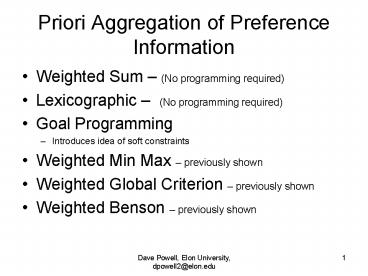Priori Aggregation of Preference Information - PowerPoint PPT Presentation
1 / 48
Title:
Priori Aggregation of Preference Information
Description:
Introduces idea of soft constraints. Weighted Min Max previously shown ... S k=1 wk = 1 and wk = 0. xi(L) = xi = xi(U) , i = 1,2, ..., n ... – PowerPoint PPT presentation
Number of Views:35
Avg rating:3.0/5.0
Title: Priori Aggregation of Preference Information
1
Priori Aggregation of Preference Information
- Weighted Sum (No programming required)
- Lexicographic (No programming required)
- Goal Programming
- Introduces idea of soft constraints
- Weighted Min Max previously shown
- Weighted Global Criterion previously shown
- Weighted Benson previously shown
2
Weighted Sum Approach
- Minimize f(x) S wkfk(x) k1,..,K
- Subject to gj(x) lt 0, j 1,2,.,J
- hm(x) 0, m 1,2,.,M
- K
- S k1 wk 1 and wkgt 0
- xi(L) lt xi lt xi(U) , i 1,2, , n
- Need to normalize each objective for weights to
be meaningful.
3
Pareto Optimal Theorems (Deb)
- The solution to the problem represented by
Weighted Sum is Pareto optimal if the weight is
positive for all objectives. - If x is a pareto-optimal solution of a convex
multi-objective optimization problem then there
exists a non-zero positive weight vector w such
that x is a solution to the problem.
4
iSIGHT-FD Formulation 1
- iSIGHT-FD Directly supports through GUI a
weighted formulation for a single set of weights. - User can add weights and normalization scale
factors and easily obtain a Pareto optimal point. - User can then adjust weighting and rerun.
5
iSIGHT-FD Formulation
Scaling is critical in all optimization single
and multiple
6
Formulation with even weighting and obj. scaling
between 1 - 10
7
Optimization Results with GRG
8
Standard Tradeoff Curve
9
Weighted Sum with Upper-Lower Bound Scaling
- Add Calculation
- Add Weight Variables
- Add Objective Variable
- Add Utopia and Nadir Variable/Points
- Modify Problem Formulation
10
Weighted Sum Scaled Calculation
11
Problem Formulation
12
Standard Tradeoff Curve Using Upper-Lower Bound
Scaling
13
Advantages and Disadvantages
- Advantage
- Simplicity
- Ease of implementation
- Disadvantages
- Uniformly distributed weight vectors need not
find a uniformly distributed set of
Pareto-optimal solutions - Cannot find certain solutions in a non convex
space.
14
Lexicographic
- Deal with one objective at a time in priority
order. - Step 1 Optimize on Area
- Step 2 Take Optimal Area and set an upper bound
constraint on Area with( 1 e / 100)
(OptimalArea) where e is a percentage - if e 0 then no compromise on gain.
- Step 3 Optimize on Static Deflection
- Possible iSIGHT implementations
- Manual No Programming Required
- Task Plan
15
Optimize on Area Formulation
16
Optimize on Area Results
Use as starting point of next optimization.
17
Set Upper Bound Constraint on Area
- User must decide on how much to allow (if any) of
Area optimum to give up while minimizing Static
Deflection. - Lets assume 30 so new bound for Area is(1
30/100) Optimal Area1.3 127.417 165.643 - Note The only objective now in StaticDeflection
18
New Problem Formulation
19
Optimize with GRG
20
Standard Tradeoff Curve
21
Lexicographic Automation
- Create hierarchical task to vary relaxation
percentages (Loop) - Create two optimization tasks sequence to
automate changing of objectives
22
Lexicographic Automation
23
Loop
24
Opt. Min Area Formulation
25
Calc Area Upper Bound
26
Opt Min Defl Formulation
27
Opt Min Defl Formulation
28
Opt Min Defl Formulation
29
Standard Tradeoff
30
Standard Tradeoff Curve
31
Goal Programming
- Choose a target value for each objective (dealing
in criterion space) - Minimize deviation from target and objective
- Create a constraint for each objective
- If minimize a goal
- Minimize PositiveDeviation from Target
- subject to F(x) PositiveDeviation lt target
- PostiveDeviation gt0
- If maximize
- Minimize NegativeDeviation from Target
- subject to F(x) NegativeDeviation gt target
- If equal to target
- Minimize PositiveDeviation Negative Deviation
from target - Subject to F(x) Positive Deviation
NegativeDeviation target
32
Goal Programming for Objective Minimization
Define targets for each objective. Targets may or
maynot be reachable Could add weights
33
Goal Programming
Figure from Deb
34
Minimization Formulation
- Single level task requires a calculation to
calculate new scaled constraint values. - Add one variable for each objective to track the
positive deviations - Minimize sum of positive deviations
- Add soft constraint for each objective(f(x)
ftarget)/(fmax foptimal) deviation lt 0 - Add constraint to insure each deviation is gt 0.
35
Calculation for Goal Programming
36
Calculation for Goal
37
Optimization Formulation for IBeam for Area goal
500 and Deflection 0.007
6 instead of 4 design variables
38
Optimization Formulation
39
Optimization with GRG
40
Standard Tradeoff Curve
41
Summary of Priori Aggregation of Preference
Information
- Weighted Sum (No programming required)
- Lexicographic (No programming required)
- Goal Programming
- Could easily extend to Weighted Goal Programming
- Could be considered to be a satisficing method
depending on attainability of targets - Weighted Global Criterion (previously
demonstrated) - Weighted Benson (previously demonstrated)
- Weighted Min Max (previously demonstrated)
42
Exercise 3
You have decided that you liked the goal
programming approach. Show the calculation that
you would add to your previous one from exercise
1. Show the problem formulation with a target
ExposuresToMen of 88 and a target
ExposuresToWomen of 88.
43
Example 3 Solution
44
Example 3 Calculation
45
Example 3 Solution
46
Example 3 Problem Formulation
47
Example 3 Problem Formulation
48
Solution































